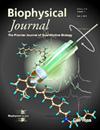EMT中重塑细胞黏附中的钙粘蛋白动力学和皮质张力。
IF 3.1
3区 生物学
Q2 BIOPHYSICS
引用次数: 0
摘要
上皮-间充质转化(epithelial -to-mesenchymal transition, EMT)是癌症转移和纤维化的关键过程,它通过用间充质N-cadherin取代上皮E-cadherin来破坏细胞粘附。然而,从e -钙粘蛋白到n -钙粘蛋白的转变如何影响分子尺度的粘附力学和簇动力学,以及这些变化如何在不同的机械和环境条件下削弱粘附,仍然知之甚少,限制了我们针对emt驱动的病理粘附动力学的能力。在这里,我们建立了一个统一的格子-离合器模型来研究EMT期间钙粘蛋白聚集、皮质张力和粘附强度。利用原子力显微镜(AFM)实验,我们测量了不同条件下单个钙粘蛋白反式键和钙粘蛋白介导的细胞-细胞和细胞-基质粘附的力学性能。我们的研究结果表明,n -钙粘蛋白反式键的机械强度弱于e -钙粘蛋白反式键,导致EMT过程中粘附强度降低。计算模型和实验验证进一步表明,EMT损害钙粘蛋白聚集和皮质张力调节,这共同削弱了细胞-细胞和细胞-基质的粘附,特别是在坚硬的底物上。这些发现强调了EMT如何在多个尺度上破坏粘附强度——从单个钙粘蛋白键到集体簇动力学。我们的研究阐明了emt驱动的钙粘蛋白类型的变化是如何削弱粘附强度和机械转导的,为细胞粘附机制和针对emt相关疾病(如癌症转移和组织重塑)的潜在治疗策略提供了见解。本文章由计算机程序翻译,如有差异,请以英文原文为准。
Cadherin Dynamics and Cortical Tension in Remodeling Cell-Cell Adhesion During EMT.
Epithelial-to-mesenchymal transition (EMT), a key process in cancer metastasis and fibrosis, disrupts cellular adhesion by replacing epithelial E-cadherin with mesenchymal N-cadherin. While, how the shift from E-cadherin to N-cadherin impacts molecular-scale adhesion mechanics and cluster dynamics-and how these changes weaken adhesion under varying mechanical and environmental conditions-remains poorly understood, limiting our ability to target EMT-driven pathological adhesion dynamics. Here, we developed a unified Lattice-Clutch model to investigate cadherin clustering, cortical tension, and adhesion strength during EMT. Using atomic force microscopy (AFM) experiments, we measured the mechanical properties of single cadherin trans-bonds and cadherin-mediated cell-cell and cell-matrix adhesions across varying conditions. Our results demonstrate that N-cadherin trans-bonds are mechanically weaker than E-cadherin trans-bonds, leading to reduced adhesion strength during EMT. Computational modeling and experimental validation further revealed that EMT impairs cadherin clustering and cortical tension regulation, which collectively weaken both cell-cell and cell-matrix adhesions, particularly on stiff substrates. These findings highlight how EMT disrupts adhesion strength at multiple scales-from individual cadherin bonds to collective cluster dynamics. Our study elucidates how EMT-driven changes in cadherin type weaken adhesion strength and mechanotransduction, providing insights into cellular adhesion mechanics and potential therapeutic strategies for targeting EMT-associated diseases such as cancer metastasis and tissue remodeling.
求助全文
通过发布文献求助,成功后即可免费获取论文全文。
去求助
来源期刊

Biophysical journal
生物-生物物理
CiteScore
6.10
自引率
5.90%
发文量
3090
审稿时长
2 months
期刊介绍:
BJ publishes original articles, letters, and perspectives on important problems in modern biophysics. The papers should be written so as to be of interest to a broad community of biophysicists. BJ welcomes experimental studies that employ quantitative physical approaches for the study of biological systems, including or spanning scales from molecule to whole organism. Experimental studies of a purely descriptive or phenomenological nature, with no theoretical or mechanistic underpinning, are not appropriate for publication in BJ. Theoretical studies should offer new insights into the understanding ofexperimental results or suggest new experimentally testable hypotheses. Articles reporting significant methodological or technological advances, which have potential to open new areas of biophysical investigation, are also suitable for publication in BJ. Papers describing improvements in accuracy or speed of existing methods or extra detail within methods described previously are not suitable for BJ.
 求助内容:
求助内容: 应助结果提醒方式:
应助结果提醒方式:


